14 Fun & Interactive Presentation Games for Teams and Students

So you've got an audience to energize, students to engage, or a team that needs a little extra fun — playing an interactive presentation game is an easy way to do just that.
We've done the research and found the best of these games for you: we looked specifically for games that are simple to set up, fun to play, and flexible enough to be used with a variety of presentations and audiences. Most of these activities work virtually with Zoom/PowerPoint and can also be used in person.
Which of these 14 presentation games do you like best? Take a look and let us know your favorites:

1. Live Trivia Competition
A great way to ramp up the excitement and engagement is to enable a little bit of friendly competition. Trivia is an easy way to do this—plus, it can be whole-group inclusive and large-audience friendly (if you use the right tools).
Here's a great trivia game you can run with your team, students, or any large audience. It's already created for you with questions and scoring built in to make it even easier:
Here's how to play:
- Make a free account here: https://slideswith.com/
- Click the slide deck and copy it.
- Launch the trivia game by clicking "Start Event."
- Invite your group to join in and submit answers using their mobile devices (show the winners automatically).
- Interact and play during your presentation!
This trivia game has questions on many topics to keep your audience's attention and appeal to everyone. It only takes 10-15 minutes to play, so it's a great game for long discussions! Also, this interactive activity is free for up to ten participants and is totally customizable.
2. Sing and Swing
To really liven up your group, encourage your listeners to play Sing and Swing. This activity is best for long presentations because it boosts energy, creates a fun, light-hearted environment, and makes people laugh a lot.
Here's how to play:
- Before your presentation, pick a well-known song and rewrite the chorus (replace parts of it with words and phrases from your presentation)
- When you're ready to play, show the song on your screen.
- Invite your audience to sing it with you!
If you have a fun group or a class of energetic students, consider adding choreography to engage your audience even more.

3. 20 Questions
If you want a presentation game that requires your listeners to talk more than you, 20 Questions is the one to play! A classic and simple activity, this game immediately boosts engagement and gets people laughing.
Here's how to play: Have someone put an appropriate image or word on the screen behind you (this can be an audience member you trust or a colleague or co-presenter). To make things more fun, put on a blindfold so that everyone knows you can't cheat. From there, ask 20 "yes or no" questions to guess what's displayed on the screen. Your group should respond "yes" or "no" to guide you to the correct answer.
4. Scavenger Hunt Challenge
To get your audience out of their seats, a scavenger hunt challenge is one of the best interactive games for presentations. It'll immediately energize your audience , team, or students while giving them a fun way to learn.
There are tons of in-person and virtual scavenger hunt ideas you can use to dive deeper into your topic or help everyone learn about one another. But if you want a ready-to-play game that you can instantly launch without having any tech skills, here's a fun one to play:
- Use an email address and password to create a free account here: https://slideswith.com/ (a free account guarantees up to ten people can play at no charge).
- Click the game and press "Copy and use this slide deck."
- In the top right corner, click "Start Event."
- Ask listeners to join the game by using their mobile devices to scan the QR code. Players should continue using their mobile devices to submit answers to questions.
- Have everyone start hunting for items!
This activity is a particularly fun game because it's a photo-hunt, show-and-tell challenge! That means your audience will not only get out of their seats to find items, but they'll also get to take pictures and share and discuss photos of what they find. This conversational element will help engage your group!
5. Group Word Clouds
Whether you're speaking to team members, students, or conference-goers, this activity lets you ask questions and get your listeners' thoughts on specific topics.
This game is the perfect way to start your presentation, especially if you're discussing something with a wide range of opinions or are unsure how much your listeners know about a certain subject. Group Word Clouds is also beneficial if you want to do a quick meeting pulse or know how your listeners feel going into your presentation—understanding their energy levels and mood can help you adjust (if necessary) to get maximum engagement and excitement.
To enjoy this activity, keep things simple by using a tool that already offers a ready-to-play Group Word Clouds game. Here's a popular one you can launch immediately:
- Create a free account by entering an email and password here: https://slideswith.com/
- Click the game and then copy it (the button to do so is right underneath the slide deck).
- Press "Start Event" in the top right corner.
- Tell participants to play by scanning the QR code.
- Create word clouds and have fun!
This interactive game only takes 5-10 minutes to play, so it's a fast, fun way to engage your audience and feel out the room. Players can use their mobile devices to answer questions. This activity is also free for up to 10 people and is easy to personalize.
6. The Get to Know You Game
This activity is one of the best presentation games if you have a small group that doesn't really know each other. The Get to Know You Game is a creative way to do introductions, and it's really simple.
Here's how to play the game: Before the event, ask group members to bring a favorite song or item to the presentation (you can do this by emailing them). When you're ready to play, ask each person to introduce themself, present their song or item, and explain why they picked it. For those sharing a song, have them play it on their phones before they explain why it's their favorite.
7. Live Poll Questions
When you have a large group, it's not easy to find ways to boost engagement—but poll questions are the solutions, especially when they're live and interactive. With this unique setup, large groups engage by answering questions and seeing their answers displayed in a fun way.
Your job is to make sure you actually find a game that showcases responses uniquely to captivate your group. For a quick and great option, here's a popular icebreaker activity that promises to display responses using fun formats like word clouds, donut charts, live graphs, and per-player:
- Create an account for free to access the game: https://slideswith.com/
- Click the slide deck and press the button to copy it.
- Look in the top right corner of the deck and press "Start Event."
- Invite your group to play the game. They only need to use their mobile devices to scan the QR code.
- Start polling your audience!
This activity is one of those fun presentation games everyone will want to enjoy, so invite all of your team members and students to participate. This game can accommodate up to 250 players and takes 5-10 minutes to complete. Tell your group to use their mobile devices to submit their responses.
8. Assumptions
This interactive game is a great way to break up your presentation to see who's paying attention and who can answer questions pertaining to your topic.
- Ask your audience to stand up (for virtual presentations, make sure everyone's video is on).
- Show true or false statements on the screen one by one.
- Tell people to raise a hand if they think the statement is correct and sit down if they think it's incorrect.
- Continue until one person is left standing.
- Award the winner.
This activity can be as short and challenging as you want. Also, if your presentation is long, you can play multiple rounds to break up your speaking time and test your audience throughout your discussion.

9. Controversial Questions
Want to see where your audience, students, or team lands on controversial topics? Then, energize your presentation with a fun, creative game called Controversial Questions. This activity has prompts that inspire lively debates, so it's a great way to get your group excited and chatty.
However, to maintain a positive environment, make sure to find a tool that offers an office-friendly, classroom-friendly, and conference-friendly game. You don't want to sour the mood by creating uncomfortable division during your presentation. To make sure this game is fun and light-hearted, here's a popular one that's suitable for all audiences and ages:
- Sign up for a free account by inputting an email address and password here: https://slideswith.com/pricing
- Click the game and press the button that says, "Copy and use this deck."
- Press "Start Event" (the button is in the top right corner).
- Have participants join the fun by asking them to scan the QR code with their mobile devices.
- Get controversial and play!
This interactive game for presentations asks fun (but appropriate) questions like:
- Does pineapple belong on pizza?
- Does the person flying in the middle seat get both armrests?
- Should the toilet roll go over or under?
Players should use their mobile devices to submit answers. Up to ten people can play for free, and you can customize the game by updating the questions!
10. Word of the Day
With this activity, you can keep your audience, team, or students engaged throughout your entire presentation. This game requires listeners to be alert and recognize whenever you say the word of the day.
Here's how to play: At the beginning of your presentation, tell your group the word of the day (it can also be a phrase if you'd prefer). Say that you'll weave the word into your presentation and that your audience must shout it out whenever you mention it.
11. Mini Activity: Group Icebreaker
Whether you're doing an in-person or virtual presentation, you need to warm up your audience to get things started on a positive note. The best way to do that is with a quick icebreaker game.
However, make sure your questions are fun, positive, and engaging. You can easily do this by finding a game that already has the best icebreaker questions included. Here's one that's ready to play (and requiring no tech skills to launch):
- Input an email address and password to make a free account here: https://slideswith.com/
- Click the deck and copy it (press "Copy and use this deck).
- Click the button in the top right corner that says "Start Event."
- Invite participants to play by asking them to scan the QR code.
- Break the ice to warm up your audience!
Your group should use their mobile devices to submit responses to poll questions. Also, this game accommodates up to 250 players, but only ten people can join for free.
12. Process of Elimination
This activity is one of the best games for presentations because it's simple yet fun and great at helping listeners get to know each other. You can play it at the beginning of your presentation or in the middle to give your group a chance to stretch their legs.
- Before your event, create a list of "yes or no" questions.
- Once you're ready to play, tell your group to stand up (if you're doing a virtual presentation, make sure everyone's video is on).
- Ask each question one by one.
- Tell attendees to stand if their answer is "yes" and sit if their answer is "no."
The questions can relate to your topic or be totally random. Also, if you'd prefer to thin out the number of people standing, you can take a creative twist and ask your questions by saying something like this: "Stay standing if (insert scenario)." When phrasing each question this way, the game will end with one person standing. To acknowledge the winner, you can give them a round of applause or award them a prize.
13. Conference Opener Icebreaker
If you're speaking at a big conference, you need an interactive game for presentations that can get everyone involved and ensure every voice is heard. To achieve these goals, you should create an icebreaker game that works for large groups .
Using an easy, intuitive template is the best step to take. That way, you don't have to start from scratch or spend hours making your game. For a template that requires no code or tech-savviness to build on, here's the best option:
- Sign up by making a free account here: https://slideswith.com/
- Click on the game. On the next page, click the button to copy and use the deck.
- Customize the template using the instructions HERE .
- During your presentation, press "Start Event" in the top right corner.
- Ask the group to use their mobile devices to scan the QR code and join the fun. (Also, make sure participants use their mobile devices to submit answers.)
- Play and engage your audience!
This template has fun, interactive features built in to keep your large audience engaged. Those features include polls, word clouds, and ratings. Just make sure you sign up for a paid plan to accommodate the large number of people in your group—the free account only works for up to ten players.
14. Two Truths and a Lie
This classic game is a fun, energizing way to help your listeners get to know one another. It's perfect for small in-person or virtual groups and is an ideal activity for the beginning of your presentation.
Here's how to play: Pick any topic (for the purposes of this article, the topic will be "movies"). In no particular order, say two movies you've really watched and one you haven't watched. Ask your audience to guess which statement is the lie. The winner picks the next topic and says two truths and a lie.
Be Memorable With Presentation Games
Oftentimes, people forget presentations within a week or even days, and that's because the discussions are boring. But you don't work hard preparing a presentation for it to be forgotten. If you want your message to stick, all you have to do is make it enjoyable without being corny.
If you want to be remembered and actually get people engaged, you need to make your presentation fun and enjoyable, without coming off as corny or desperate to please. Ivan Dimitrijevic, 10 Secrets of Making Every Presentation Fun, Engaging, and Enjoyable
Luckily, the interactive presentation games in this article are unique and exciting—they're far from corny. So, use them for your upcoming presentations to make your messages compelling and memorable.
Subscribe for more articles like this
Try slides with friends for free.
The easiest way to host meetings your team will love
Engagement delivered to your inbox
We'll email you 1-2x per month with brand new, ready-to-run events and ideas. Subscribe to stay ahead of the curve and keep your lessons, meetings, and events fresh and engaging.
- Interactive Presentation
14 Interactive Presentation Games to Win Easy Engagement in 2025
Lawrence Haywood • 28 November, 2024 • 15 min read
So, how to make a presentation engaging? Audience attention is a slippery snake. It's difficult to grasp and even less easy to hold, yet you need it for a successful presentation.
No Death by PowerPoint, no to drawing monologues; it's time to bring out the interactive presentation games !
Bonus : Free slideshow game templates to use. Scroll down for more👇
These 11 games below are perfect for an interactive presentation . They'll score you mega-plus points with colleagues, students, or wherever else you need a kick of super-engaging interactivity... Hope you find these game ideas below helpful!
Table of Contents
- #1: Live Quiz
#2: What Would You Do?
#3: key number, #4: guess the order, #5: 2 truths, 1 lie, #6: 4 corners, #7: obscure word cloud, #8: heart, gun, bomb.
- #9: Match Up
#10: Spin the Wheel
#11: q&a balloons, #12: play "this or that", #13: the song remix challenge, #14: the great friendly debate, how to host interactive games for a presentation (7 tips), interactive powerpoint presentation games - yes or no, frequently asked questions.
Host Interactive Presentation Games for Free!
Add interactive elements that make the crowd go wild . Make your whole event memorable for any audience, anywhere, with AhaSlides.
More Interactive Presentation Tips with AhaSlides
- Interactive Presentation Ideas
- Interactive Games for Training Sessions
- Interactive Presentation Techniques
#1: Live Quiz Competition
Is there any event that hasn't been immediately improved with some trivia?
A live quiz is an evergreen, ever-engaging way to consolidate your presentation's info and check the understanding of it all amongst your audience. Expect big laughs as your audience competes fiercely over who was listening to your presentation the most complex.
Here's how to play:
- Set up your questions on AhaSlides .
- Present your quiz to your players, who join by typing your unique code into their phones.
- Take your players through each question, and they race to get the correct answer the fastest.
- Check the final leaderboard to reveal the winner!
Learn how to set up your presentation quiz for free in just a few minutes! 👇
Put your audience in your shoes. Give them a scenario related to your presentation and see how they would deal with it.
Let's say you're a teacher giving a presentation on dinosaurs. After presenting your info, you would ask something like...
A stegosaurus is chasing you, ready to snap you up for dinner. How do you escape?
After each person submits their answer, you can take a vote to see which is the crowd's favourite response to the scenario.
This is one of the best presentation games for students as it gets young minds whirring creatively. But it also works great in a work setting and can have a similar freeing effect, which is especially significant as a large group icebreaker .
- Create a brainstorming slide and write your scenario at the top.
- Participants join your presentation on their phones and type their responses to your scenario.
- Afterwards, each participant votes for their favourite (or top 3 favourites) answers.
- The participant with the most votes is revealed as the winner!
No matter the topic of your presentation, there's sure to be a lot of numbers and figures flying around.
As an audience member, keeping track of them isn't always easy, but one of the interactive presentation games that makes it easier is Key Number .
Here, you offer a simple prompt of a number, and the audience responds with what they think it refers to. For example, if you write ' $25' , your audience might respond with 'our cost per acquisition' , 'our daily budget for TikTok advertising' or 'the amount John spends on jelly tots every day' .
- Create a few multiple-choice slides (or open-ended slides to make it more complicated).
- Write your key number at the top of each slide.
- Write the answer options.
- Participants join your presentation on their phones.
- Participants select the answer they think the critical number relates to (or type in their answer if open-ended).

If keeping track of numbers and figures is challenging, it can be even tougher to follow entire processes or workflows explained in a presentation.
To cement this information in your audience's mind, Guess the Order is a fantastic minigame for presentations.
You write the steps of a process, jumble them up, and then see who can put them in the right order the fastest.
- Create a 'Correct Order' slide and write your statements.
- Statements are automatically jumbled up.
- Players join your presentation on their phones.
- Players race to put the statements in the correct order.
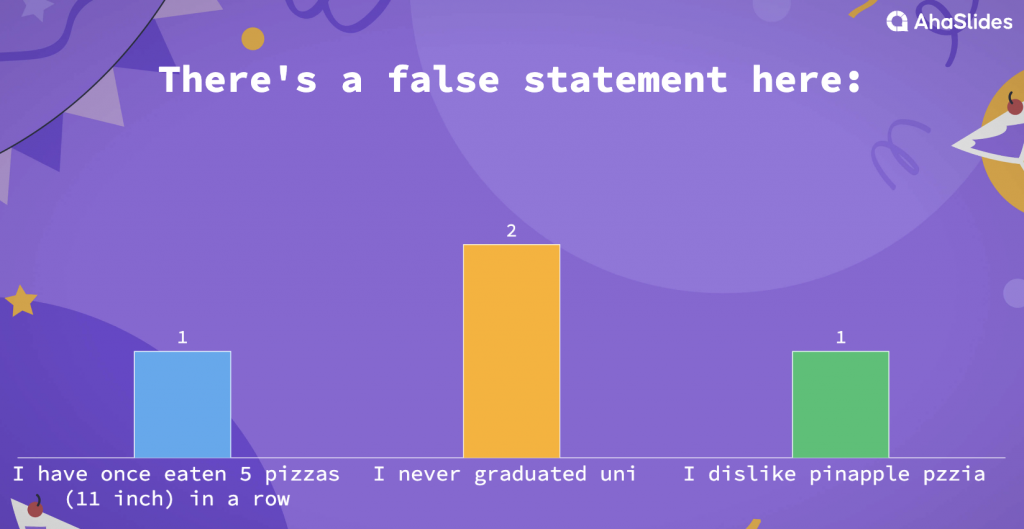
You might have heard of this one as a great icebreaker, but it's also one of the top interactive games to play during a presentation for checking who's paying attention.
And it's pretty simple to do. Just think of two statements using the information in your presentation, and make another one up. Players have to guess which is the one you've made up.
This one is a great re-capping game and works for students and colleagues.
- Create a list of 2 truths and one lie covering different topics in your presentation.
- Read out two truths and one lie and get participants to guess the lie.
- Participants vote for the lie either by hand or through a multiple-choice slide in your presentation.
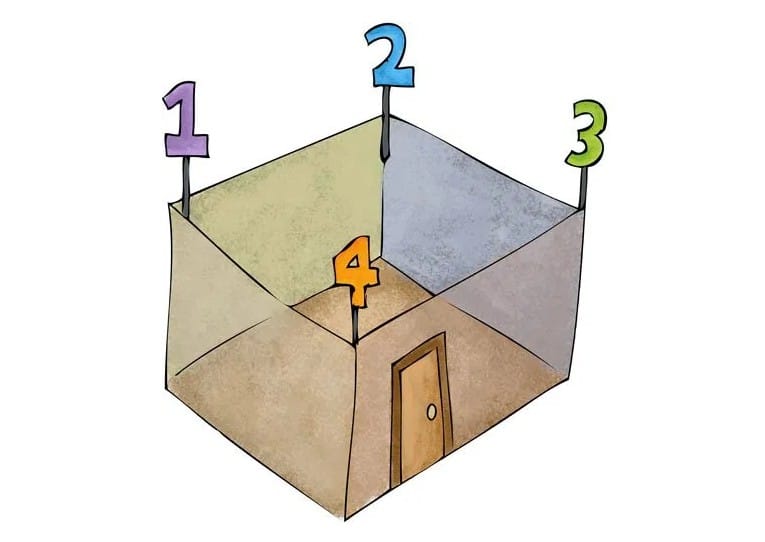
The best presentations are ones that spark a bit of creative thinking and discussion. There's no better presentation game for evoking this than 4 Corners.
The concept is simple. Present a statement based on something from your presentation that's open to different points of view. Depending on each player's opinion, they move to a corner of the room labelled 'strongly agree', 'agree', 'disagree' or 'strongly disagree' .
Maybe something like this:
An individual is shaped more by nature than nurture.
Once everyone is in their corner, you could have a structured debate between the four sides to bring different opinions to the table.
- Set up the 'strongly agree', 'agree', 'disagree' and 'strongly disagree' corners of your room (if running a virtual presentation, then a simple show of hands could work).
- Write some statements which are open to different opinions.
- Read out the statement.
- Each player stands in the right corner of the room, depending on their view.
- Discuss the four different viewpoints.
Besides games, these interactive multimedia presentation examples can also lighten your next talks.
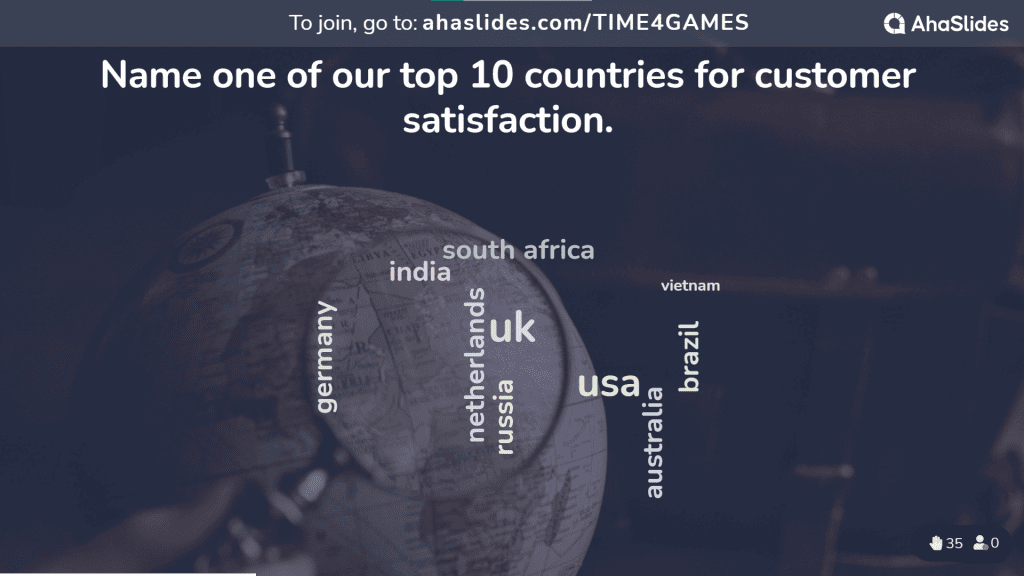
Word cloud is always a beautiful addition to any interactive presentation. If you want our advice, include them whenever you can - presentation games or not.
If you do plan to use one for a game in your presentation, a great one to try is Obscure Word Cloud .
It works on the same concept as the popular UK game show Pointless . Your players are given a statement and have to name the most obscure answer they can. The least-mentioned correct answer is the winner!
Take this example statement:
Name one of our top 10 countries for customer satisfaction.
The most popular answers may be India, USA and Brazil , but the points go to the least mentioned correct country.
- Create a word cloud slide with your statement at the top.
- Players submit the most obscure answer they can think of.
- The most obscure one appears most diminutive on the board. Whoever submitted that answer is the winner!
Word Clouds for Every Presentation
Get these word cloud templates when you sign up for free with AhaSlides!
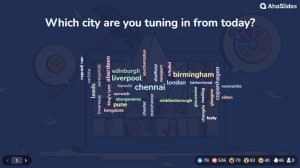
For Ice Breaking
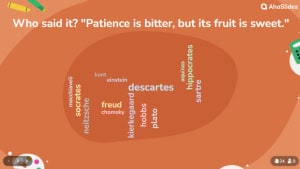
For Testing
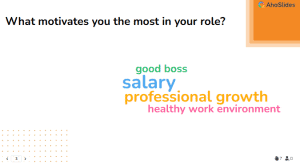
This one's a great game to use in the classroom, but if you're not looking for students' games for presentation, it also works wonders in a casual work setting.
Heart, Gun, Bomb is a game in which teams take turns to answer questions presented in a grid. If they get an answer right, they either get a heart, a gun or a bomb...
- A ❤️ grants the team an extra life.
- A 🔫 takes away one life from any other team.
- A 💣 takes away one heart from the team who got it.
All teams start with five hearts. The team with the most hearts at the end, or the only surviving team, is the winner!
- Before starting, create a grid table for yourself with either a heart, gun or bomb occupying each grid (on a 5x5 grid, this should be 12 hearts, nine guns and four bombs).
- Present another grid table to your players (5x5 for two teams, 6x6 for three groups, etc.)
- Write a figure stat (like 25%) from your presentation into each grid.
- Split players into the desired number of teams.
- Team 1 chooses a grid and says the meaning behind the number ( for example, the number of customers last quarter ).
- If they're wrong, they lose a heart. If they're right, they get either a seat, gun or bomb, depending on what the grid corresponds to on your grid table.
- Repeat this with all the teams until there's a winner!
👉 Get more interactive presentation ideas from AhaSlides.
#9: Match Up - Interactive Presentation Games
Here's another quiz-type question that can be a great addition to your roster of interactive activities for presentations.
It involves a set of prompt statements and a set of answers. Each group is jumbled; the players must match the information with the correct answer as quickly as possible.
Again, this one works well when the answers are numbers and figures.
- Create a 'Match Pairs' question.
- Fill out the set of prompts and answers, which will automatically shuffle.
- Players match each prompt with its answer as fast as possible to score the most points.
If there's a more versatile presentation game tool than the humble spinner wheel , we aren't aware of it.
Adding the random factor of a spinner wheel might be just what you need to keep engagement in your presentation high. There are presentation games you can use with this, including...
- Choosing a random participant to answer a question.
- Choose a bonus prize after getting the correct answer.
- Choosing the next person to ask a Q&A question or give a presentation.
- Create a spinner wheel slide and write the title at the top.
- Write the entries for the spinner wheel.
- Spin the wheel and see where it lands!
Tip 💡 You can choose the AhaSlides spinner wheel to use your participants' names, so you don't have to fill in the entries manually! Learn more interactive presentation techniques with AhaSlides.
This one's a great way to turn a regular end-of-presentation feature into a fun, engaging game.
It's got all the hallmarks of a standard Q&A, but this time, all the questions are written on balloons.
It's a super simple one to set up and play, but you'll see how motivated participants are to ask questions when it involves balloons!
- Hand out a deflated balloon and a Sharpie to each participant.
- Each participant blows up the balloon and writes their question on it.
- Each participant bats their balloon to where the speaker is standing.
- The speaker answers the question and then pops or throws away the balloon.
🎉 Tips: Try the best Q&A apps to engage with your audience
A simple way to get everyone talking is the "This or That" game. It's perfect when you want people to share their thoughts in a fun way, without any pressure.
- Show two choices on the screen - they can be silly or work-related. For instance, "Work from home in pajamas OR work in office with free lunch?"
- Everyone votes using their phones or by moving to different sides of the room.
- After voting, invite a few people to share why they chose their answer. P/s: This game works great with AhaSlides because everyone can vote at once and see the results instantly.
Want to add some laughs to your presentation? Try turning your main points into a catchy song. Don't worry - it's supposed to be a bit silly!
- Take a famous song everyone knows (like "Happy" by Pharrell Williams) and change some words to match your presentation topic.
- Write the new lyrics on the screen and ask everyone to sing along. For example, if you're talking about customer service, you might change "Because I'm happy" to "Because we're helpful."
- If your group seems shy, start with humming or clapping first to help them feel more comfortable.

Sometimes the best discussions start with simple questions that everyone has an opinion about. This game gets people talking and laughing together.
- Pick a fun topic that won't upset anyone - like "Does pineapple belong on pizza?" or "Is it okay to wear socks with sandals?"
- Put the question on the screen and let people pick sides.
- Ask each group to come up with three funny reasons to support their choice.
- The key is keeping it light and playful - remember, there are no wrong answers here!
Keep Things Easy
When you want to make your presentation fun, don't overcomplicate it. Pick games with simple rules that everyone can quickly get. Short games that take 5-10 minutes are perfect - they keep people interested without taking too long. Think of it like playing a quick round of trivia rather than setting up a complex board game.
Check Your Tools First
Get to know your presentation tools before you start. If you're using AhaSlides, spend some time playing with it so you know where all the buttons are. Make sure you can tell people exactly how to join in, whether they're in the room with you or joining online from home.
Make Everyone Feel Welcome
Choose games that work for everyone in the room. Some people might be experts, while others are just starting out - pick activities where both can have fun. Think about your audience's different backgrounds too, and avoid anything that might make some people feel left out.
Connect Games to Your Message
Use games that actually help teach what you're talking about. For example, if you're talking about teamwork, use a group quiz instead of just a solo activity. Put your games at good spots in your talk - like when people look tired or after a chunk of heavy information.
Show Your Own Excitement
If you're excited about the games, your audience will be too! Be upbeat and encouraging. A little friendly competition can be fun - maybe offer small prizes or just bragging rights. But remember, the main goal is learning and having fun, not just winning.
Have a Backup Plan
Sometimes technology doesn't work as planned, so have a Plan B ready. Maybe print out some paper versions of your games or have a simple activity ready that doesn't need any special tools. Also, have different ways for shy people to join in, like working in teams or helping keep score.
Watch and Learn
Pay attention to how people react to your games. Are they smiling and getting involved, or do they look confused? Ask them afterward what they thought - what was fun, what was tricky? This helps you make your next presentation even better.
So, how do you feel about AhaSlides's interactive ideas for presentations? Being by far the most popular presentation tool on the planet, you may want to know if there are any presentation games to play on PowerPoint.
Unfortunately, the answer is no. PowerPoint takes presentations incredibly seriously and doesn't have a lot of time for interactivity or fun of any kind.
But there's good news...
It is possible to directly embed presentation games into PowerPoint presentations with free help from AhaSlides.
You can import your PowerPoint presentation to AhaSlides with the click of a button and vice versa , then place interactive presentation games like the ones above directly between your presentation slides.
💡 PowerPoint presentation games in less than 5 minutes ? Check the video below or our quick tutorial here to find out how!
Or, you can also build your interactive slides with AhaSlides directly on PowerPoint with the AhaSlides add-in ! Super simple:
What are the benefits of playing interactive presentation games?
Interactive games to play during a presentation can boost engagement, participation and knowledge retention. They turn passive listeners into active learners by incorporating elements like live polls , idea boards , quizzes, word clouds and Q&A .
How do you make a presentation interactive with games?
- Match your content: The game should reinforce the topics being covered, not just be random entertainment. - Audience considerations: Age, group size, and knowledge level will inform game complexity. - Tech tools & time: Consider similar games to Kahoot , etc., or design simple no-tech games based on the time you have. - Utilise appropriate questions, including icebreaker game questions or general knowledge quiz questions .
How can I make my presentation more engaging?
Making presentations more engaging can be a challenge, but there are several techniques you can use to make your presentation more interesting and memorable, including (1) starting with a strong opening (2) using lots of visual ads and (3) telling an attractive story. Also, remember to keep it short and sweet, and of course, practice a lot!

Lawrence Haywood
Former ESL teacher and quiz master converted to the wild slide. Now a content creator, traveller, musician and big time slider preaching the good word of interactivity.
Tips to Engage with Polls & Trivia
More from AhaSlides

Blog > The 10 best PowerPoint Games to play in Workshops, Classrooms & Presentations
The 10 best PowerPoint Games to play in Workshops, Classrooms & Presentations
01.01.20 • #fun #game #powerpoint #presentation.
In our last blog post, we talked about tools and tips on how to boost the audience engagement in your presentation. One of our recommended ways to do so was to play games, as they release tension and function as a fun element that lightens the mood. That’s why today we are going to list the Top 10 best games to play in your presentation.
1. Would you rather
Is it a game that everyone knows already? Probably. But did we have to include it on the list because it is just perfect for playing with your audience? Definitely. The game is pretty much self-explanatory – You give your attendees two (or more) scenarios and they have to choose which one they’d rather experience. Combining the Would you rather – question with your presentation topic is usually very easy, but we also thought of some questions you could use for any topic (e.g. as an icebreaker, to get to know your audience a little better, to ask about their opinion or just as a fun element in between). You can let your audience vote by letting them raise their hands or by using an interactive poll tool such as SlideLizard .
- Would you rather A. travel back in time OR B. travel to the future OR C. stay in the present
- Would you rather A. have a long lunch break now OR B. have a short break and finish early
- Would you rather A. be able to read minds OR B. be able to fly OR C. be able to turn invisible
- Would you rather A. receive a letter from Hogwarts OR B. join Frodo on his journey OR C. Hog-what?
- Would you rather A. never be able to go on Social Media again B. never be able to read a book again

2. Charades
The popular game is not only great for your family’s game-night, but also for your presentations and workshops. Prepare a few cards that have words related to your presentation’s topic on them, let some volunteers in your audience draw and act them out. The rest of the audience has to guess the word. You can be sure that these terms and the associated performances will never be forgotten!

Small Trivia quizzes are perfect for checking and manifesting the audience’s knowledge at the end of your presentation. Instead of repeating and summing up what you have already said, you can let your participants test their knowledge right away. However, you can also use a quiz in the beginning to test your audience’s existing knowledge about a topic. But there are not only trivia quizzes: Questions about personality can also be interesting and work well as an ice breaker in the beginning. Again, we recommend a tool for poll creation, as that is the easiest way to conduct quizzes. In a recent article we listed 50 great questions (a mix of personality and trivia) , that you could use for your next presentation! And if you're a fan of quiz game shows, we also got a full Who wants to be a Millionaire PowerPoint template for you to download for free! You'll see how it looks like in the following video (be sure to turn up your sound!):
PowerPoint can be used for way more than most people know. Even we were amazed by people on the internet who created extensive games by animating content using PP. We don’t want to go that big today, but we are going to provide you with a free-to-download template of memory. You only have to add it to your presentation and customize the pictures or terms you want under the cards. Download free PPT Memory Template
5. Two Truths and a Lie
Here is another game that is just perfect when you play it with interactive poll tools. It is great for getting the audience to know you as a presenter better. Think of a fun, interesting or astonishing fact about yourself, and then invent two fake ones. Your attendees have to vote which statement they think is true. Be prepared to see some very surprised faces in your audience!

6. PowerPoint Karaoke
PowerPoint-Karaoke is the perfect improvisation game. Players are confronted with a set of slides they have never seen before and try to give a presentation as convincingly as possible. If you want to know all about this game and get some slides you can use for playing, check out our detailed blog post on PowerPoint-Karaoke .

7. Where do you stand?
For the game “Where do you stand?”, your attendees will actually have to stand up. Therefore, it is only convenient if you have enough space. If you want to get your participant’s opinion about something and get them to move a little, look no further! Create an imaginary line across the room. One end stands for one opinion, the other end for the exact opposite opinion. Your attendees can now place themselves on this line wherever they like (right in the middle, on either end or somewhere in between). You can then even interview people on the line (it is always interesting to choose two from opposite sites) and learn about their views. If you’re a little overwhelmed now, here are some examples you could use for this game:
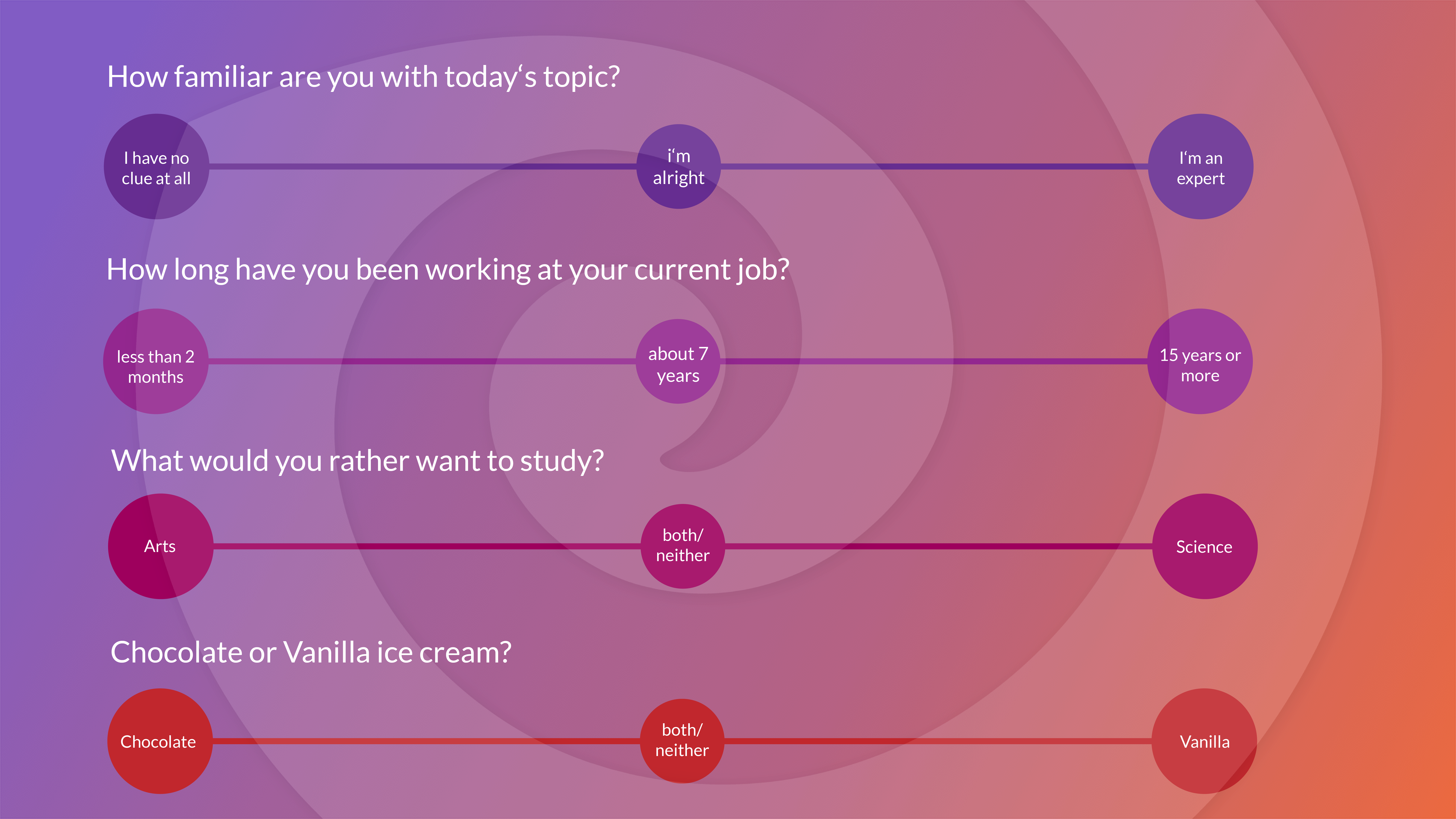
Attention – you can of course ask about political or more controversial topics, but that may escalate and turn into a fight, which is not the purpose of the game or your presentation.
8. Describe That
Let your audience draw from cards with words on them and then describe it for the other attendees. It is basically like charades, but with words instead of acting. Some may find that too easy. In that case, you can either choose terms that are extremely hard to describe or add some “Taboo-words” to the card that can’t be used for describing.

9. True and False
Have you ever heard a crazy, bizarre fact where you didn’t think that it could be true? Perfect. You can use it in the well-known “True and False”-Game. You pick out a fact (ideally something related to your presentation topic) and then let your audience vote (you know – via an interactive poll tool like SlideLizard ) if they think it’s true or not. A tip for making statements false: Change little things about the them, like numbers, dates or names or use common misconceptions and see how many of your attendees buy into them, e.g. “Bulls are enraged by the color red” (which is false, bulls are simply enraged by movement, not specific colors).

10. The never-ending sentence
The never-ending sentence is a great game that incorporates many of your attendees and awakens their brain cells. It is perfect for keeping up their engagement and interest, especially for long presentations or workshops when you feel like some people are getting a little tired. Simply start by saying a word – it can be related to the presentation’s topic if you want – and ask a person in your audience to repeat that word and add another one – the next person to repeat those two words and add another one as well , and so on, until a sentence forms. As it gets longer the game gets a lot more difficult, because there is a lot more to remember and to repeat. The sentence can’t be ended, it has to be continued until someone makes a mistake (or until the last person in the room has added a new word). We promise that you will be left with a lot of fun, creative, and straight-up weird sentences that will make your audience laugh a lot.

Related articles
About the author.

Pia Lehner-Mittermaier
Pia works in Marketing as a graphic designer and writer at SlideLizard. She uses her vivid imagination and creativity to produce good content.
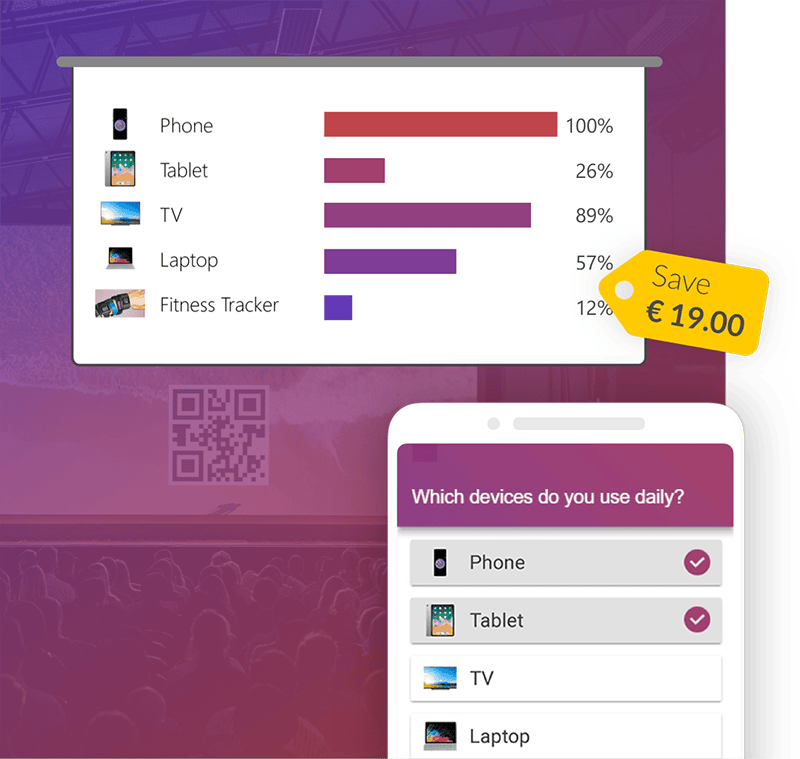
Get 1 Month for free!
Do you want to make your presentations more interactive.
With SlideLizard you can engage your audience with live polls, questions and feedback . Directly within your PowerPoint Presentation. Learn more

Top blog articles More posts

Business & Charts - Free PowerPoint Template

Who Wants to be a Millionaire - PowerPoint Quiz Template
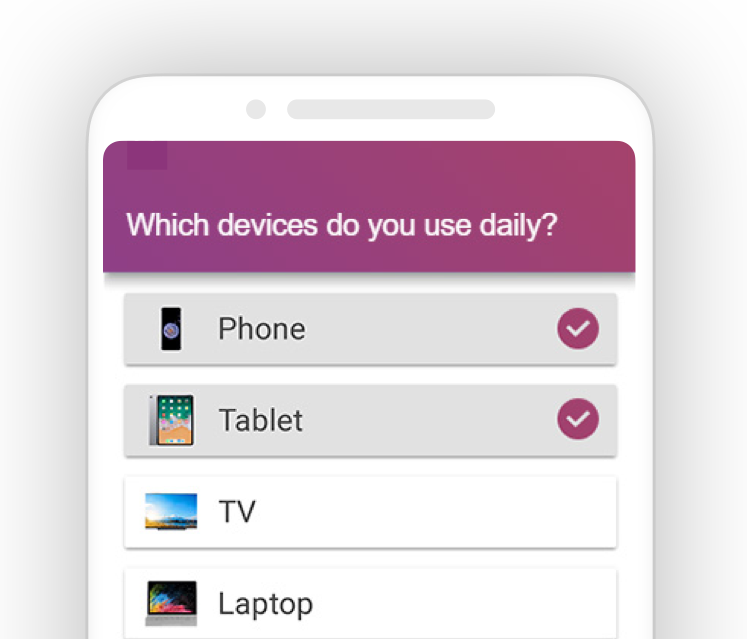
Get started with Live Polls, Q&A and slides
for your PowerPoint Presentations
The big SlideLizard presentation glossary
External communication.
External communication is the exchange of information between two organisations. For example, it can be an exchange with customers, clients or traders. Feedback from a customer also counts as external communication.
Leading Questions
Leading questions subconsciously make the respondent think in a certain direction.
Audience Demographics
Audience Demographics are the characteristics of listeners like age, gender, cultural backgrounds, group affiliations and educational level. The speaker has to consider all these characteristics when adapting to an audience.
Audience Dynamics
Audience Dynamics means the motivations, attitudes, beliefs and values, which influence the listener's behaviour.
Be the first to know!
The latest SlideLizard news, articles, and resources, sent straight to your inbox.
- or follow us on -
We use cookies to personalize content and analyze traffic to our website. You can choose to accept only cookies that are necessary for the website to function or to also allow tracking cookies. For more information, please see our privacy policy .
Cookie Settings
Necessary cookies are required for the proper functioning of the website. These cookies ensure basic functionalities and security features of the website.
Analytical cookies are used to understand how visitors interact with the website. These cookies help provide information about the number of visitors, etc.
- Virtual Experiences
- In-Person Experiences
- Hybrid Experiences
- Attend a Demo
- Experience FAQ
- Features & Benefits
- How Pricing Works
- Client Testimonials
- Happiness Guarantee
- Schedule Call
- View Experiences
15 Engaging Presentation Games to Boost Your Next Workshop
By: Angela Robinson | Updated: October 03, 2024
You found our list of fun presentation games .
Presentation games are interactive activities designed to engage audiences during workshops or meetings. For example, participants might participate in a ‘Slideshow Party,’ tackle a ‘Scenario Role Play,’ or play ‘Question Roulette.’ these games aim to get the audience more involved, spark interest, and foster connection.
These games are types of team building exercises similar to meeting ideas and topics .

This list includes:
- office presentation games
- virtual presentation games
- quick presentation games
- games to play during presentations
- presentation ice breakers
Let’s get to it!
List of presentation games
From Slideshow Party to Trivia Challenge, here is our list of the presentation slideshow games.
1. Slideshow Party
A Slideshow Party is an enjoyable presentation game where participants create entertaining slideshows on different topics. Participants can be creative with their slides, incorporating humor, visuals, and intriguing facts to entertain the audience. This game promotes teamwork and creativity while sharpening public speaking skills. The activity also gives teammates a glimpse into their coworkers’ interests, passions, and life outside work.
2. Presentations on the Fly
Presentations on the Fly challenges participants to improvise presentations with minimal preparation. First, teams will make slideshows with random images, words, and charts. Then, other teams or coworkers will have to present those slideshows without knowing what is on the slide. This game challenges participants to think and react quickly and use improv skills. At the end of the game, teams will vote on which team presented the most coherent and convincing slideshow.
Engaging in this activity fosters confidence and quick thinking, helping individuals become more at ease with impromptu speaking. The game also sparks creativity and is sure to inspire laughter.
Get our free team building toolbox
- icebreaker games
- bingo cards

3. PechaKucha
PechaKucha is a presentation style where you show 20 slides for 20 seconds each, totaling 6 minutes and 40 seconds. This format pushes speakers to be brief and impactful. PechaKucha is popular worldwide because it is quick and engaging. Speakers must use their words and images carefully to get their message across in the short time given. This method encourages creativity, clear communication, and keeps the audience involved.
You can turn PechaKucha into a fun game by having teams compete to create the most creative and compelling presentation in just 6 minutes and 40 seconds. Each team gets random topics or images to include, and the audience votes on which team delivered the most engaging and entertaining presentation.
4. Jeopardy
Jeopardy is one of the most popular office presentation games. This activity is easy to set up, as many pre-made templates are online.
Set up a Jeopardy board on a screen or whiteboard with categories related to your work or project topics.
Divide the team into groups and have them choose questions from the board, just like in the game show. Each question has different point values based on difficulty.
When a team selects a question, read it aloud and give them a chance to answer. If they answer correctly, they earn points; if not, other teams can buzz in to steal.
This game makes the meeting more engaging, reinforces knowledge, and encourages teamwork while having fun.
Here is a guide to playing team building Jeopardy .
5. Question Roulette
Question Roulette adds excitement to presentations by making them more interactive. Participants spin a virtual wheel to get a random question about the topic. This keeps the session lively, encourages the audience to participate, and helps deepen understanding by connecting different parts of the content.
Here is a YouTube tutorial showing you how to make a spinning wheel in PowerPoint.
You can also include random icebreaker questions as re-energizers during meetings.Learn more about random question generator
6. Zoomed In
In Zoomed In, players must identify objects shown in extreme close-ups. Simply make a slideshow with ultra zoomed-in photos of everyday items. If you want, you can put objects on multiple slides, with each successive slide less zoomed-in. Players will receive more points based on how quickly they correctly guess the object.
This exercise is a fun game that hones observation skills and provides a fresh take on visual challenges, improving cognitive abilities and creativity.
7. Idea Pitch
Idea Pitch is one of the most fun games to play during presentations. This exercise turns presentation practice into a fun competition. Participants quickly pitch a random product or business idea to a panel or their colleagues, who act as potential investors or clients. With only a few minutes to prepare, players practice quick thinking and creativity. Judges rate pitches based on clarity, creativity, persuasiveness, and feasibility, helping improve various professional skills.
8. Brainstorm Race
Brainstorm Race is a fun, fast-paced game where teams develop ideas quickly. Players compete to find creative solutions within a set time. This game boosts creativity, teamwork, and communication. To play, create a slideshow with a central idea on each slide. Then, have teams brainstorm around that topic. We recommend spending three to five minutes on each slide.
The exercise is a great way to kick off presentations or training by encouraging fresh ideas and new perspectives.
Similarly, here are brainwriting ideas .
9. Opinion Polls
Opinion Polls make one of the best quick presentation games.
Fun opinion polls are a great way to make meetings more interactive and enjoyable while encouraging team members to share their thoughts in a low-pressure way. As part of a presentation game, polls can break up the flow, spark discussion, and engage the whole group.
- Which superpower would be most useful at work?
- What’s your go-to workday snack?
- If our team could have an unlimited budget for one office perk, what should it be?
- What should our office theme song be?
The best way to play is to make the poll questions multiple-choice and include two or four options employees can vote on.
These polls lighten the mood and provide valuable insights into team preferences and attitudes.
Here are poll questions for inspiration.
10. Tag Team Talks
Tag Team Talks is a lively game where team members work together to give a speech. Players take turns speaking and smoothly pass the discussion back and forth. This exercise helps improve teamwork, communication, and quick thinking. It also boosts public speaking skills and encourages cooperation.
11. Snap Judgement
In Snap Judgement, players make quick decisions with limited information to boost critical thinking. This game helps improve fast thinking and decision-making skills.
To play the game during presentations, put a scenario on each slide.
Example serious scenarios:
You find an error in your report before a meeting. What do you do?
- Your presentation tech fails. What’s your backup plan?
- You need to present on an unfamiliar topic in one day. How do you prepare?
- A project deadline conflicts with a major event. How do you manage both?
Example silly scenarios:
- You see a famous person in public. What’s your move?
- You get stuck in an elevator. How do you stay calm?
- You find a hidden treasure in your backyard. What’s your next step?
- You find a real dragon, but it turns invisible every time someone else comes around. What do you do with it?
To make the game more fun, you can stipulate that you must reach a unanimous decision or the majority vote on the final decision before moving on to the next slide.

12. Brief Debates
Teams can add some fun to presentations by having short, non-serious debates. In this game, participants quickly debate light-hearted or silly topics, encouraging creative thinking and lively interaction. This activity helps improve communication skills and teamwork while keeping the atmosphere enjoyable. Here are some fun and interesting debate topics to use:
- Pineapple on pizza: Delicious or disaster?
- Superheroes vs. villains: Who would win in a dance-off?
- Is it better to communicate only through interpretive dance or using only emojis for a week?
- Is it more practical to have the ability to teleport but only to random locations or to fly but only at walking speed?
These playful debates allow team members to practice expressing their ideas persuasively while having a good time.
13. Memory Challenge
Memory Challenge is a fun game for team members during a work presentation. First, show the team a slide with a picture for ten seconds. Then, switch to a new slide and ask teams to answer questions about the first slide. You can make the second slide the same as the first slide, only with a few objects missing that players must identify. Or, put observational questions on the second slide, like “ho” many dancing ducks were there?” or “What was written in the diary?”
14. Pitch Your Worst Idea
Presenting your worst idea can be a fun way to boost creativity and problem-solving. Thinking of silly or bad ideas helps teams develop new and surprising solutions. In this game, teammates must pitch bad ideas in convincing ways.
The exercise encourages teamwork and brainstorming without fear of judgment. Sharing these ideas in a safe space can lead to great concepts and make mistakes seem less scary. Embracing failure and trying unusual ideas can lead to unexpected and innovative results.
If that idea is too intimidating, then you could instead pitch non-serious, non-work ideas instead. For example, “A pillow that plays lullabies in reverse – To help you wake up energized.”
15. Trivia Challenge
You can add a Trivia Challenge game to your presentation to make it more engaging. Using fun trivia questions will entertain your audience and test their knowledge. This game encourages participation and highlights key points in a fun way. Trivia works well as an icebreaker or to boost energy during the presentation.
Kahoot! is a popular choice for both in-person and virtual presentation games.
However, here are some Kahoot! alternatives .
Final Thoughts
Adding presentation games to your workshops makes the sessions more exciting and memorable. These games boost creativity and teamwork, help reinforce what is being taught, and keep energy levels high. You can also add these games to team meetings or socials.
Next, check out our posts on Zoom games , marketing games , and active listening activities .
Book wildly fun team building events with expert hosts

FAQ: Presentation games
Here are frequently asked questions about presentation games.
What are presentation games
Presentation games are structured activities used during workshops or meetings to engage participants actively and make learning more dynamic.
Why use games in presentations
Using games in presentations helps maintain audience engagement, enhances information retention, and breaks the monotony of traditional speaking formats.
How to choose the right presentation games?
To choose the right presentation game, consider your audience’s demographics, the objectives of your session, and the environment in which you are presenting.
Can presentation games improve team building?
Yes, presentation games can significantly improve team building by fostering communication, collaboration, and problem-solving among team members.
What are fun, quick games for presentations?
“Zoomed In” and “Opinion Polls” are examples of fun, quick games that can liven up any presentation.

Author: Angela Robinson
Marketing Coordinator at teambuilding.com. Angela has a Master of Fine Arts in Creative Writing and worked as a community manager with Yelp to plan events for businesses.
Leave a Reply Cancel
Your email address will not be published.

Marketing Coordinator at teambuilding.com.
Angela has a Master of Fine Arts in Creative Writing and worked as a community manager with Yelp to plan events for businesses.
- 45,000+ clients including Apple, Amazon, Google and NASA
- 50,225+ five star reviews on Google
- #15 on Inc 5000's List of Fastest Growing Private Companies in America for 2022
- 80+ happy remote employees
We lead wildly fun experiences for teams with 1,000,000+ players to date.

4.96 / 5.0 rating on
50,225 Google Reviews
Get our free team building tool box
$49 value at no cost..
- May as well check it out?
- 100+ tested icebreaker questions
- 24+ themed Bingo generators
- 5+ PDFs (including the 8% Rule)
- 2024 team building calendar and more...

Enter your email for instant access
20 Interactive Presentation Games
- Employee Engagement , Event Planning , Leadership Techniques

Meetings and conferences can be painfully tedious and dull. Learning how to make powerpoints more engaging is on everyones agenda. So much so that the phrase “Death by PowerPoint” has made it into our lexicon. According to Thomas Sowell , an American political economist and commentator, “People who enjoy meetings should not be in charge of anything.”
But if the problem with meetings is that they tend to be boring, the solution lies in finding ways to better engage and entertain your audience. You probably know the feeling of sitting in a meeting, trying to pay attention while one person drones on for an hour.
Even if the purpose of the meeting is to train, disseminate new developments, or even get everyone up to speed on weekly goals, engaging your audience creates a motivation to pay attention.
That’s why interactive presentation games are a great way to re-energizing meetings by involving audiences in the presentation. Interactive presentation turn passive listeners into active participants. Audience participation games also allow the attendees to learn new skills, think of solutions within a short time period, and solve problems together.
MeetingPulse’s audience participation tools equip your team with the tools and resources to create engaging events. With that in mind, here’s our guide to a few popular interactive presentation games.
20 Interactive Audience Participation Games
1. project jeopardy.

This game is designed to make the presentation of reports more fun and interactive. The lead person on the report creates cards that have answers from the report.
For example, the card reads “25%.” The rest of the team is supposed to ask the correct question corresponding to the “25%” answer on the card. The question could be something like, “What was the company revenue growth for the quarter?”
How to play: Give everyone the URL to your MeetingPulse meeting. Display the question on your screen and create multiple choice answers or leave it open-ended. The answers will pop up on the administrator’s screen in real-time, and you can share the answers to see how many people got it right.
2. Idea Box Game

The Idea Box game is excellent for brainstorming meetings where employees can share ideas about a project or product . It helps get the creative juices flowing and might even lead to some usable prototypes. Instead of having one speaker after another speak about their idea, having a team create an idea box creates a space for collaboration to further spark innovation.
How to play: Use the MeetingPulse brainstorming tool to have teams vote and collect feedback about the products. Have each attendee log in to your MeetingPulse link — a virtual Idea Box. Give small groups thirty minutes to brainstorm, then allow submissions.
At the end of the exercise, each team should have the product name, features and functions, marketing taglines, and other vital product details.
Once each team has completed their box they’re invited to share it with the rest of the team who finally vote for the best box. Their ideas will appear on the screen right away, and participants can upvote or downvote in Reddit-style fashion and even submit emoji reactions.
3. The Introduction Game

This game is ideal for a new group of team members meeting for the first time on a mutual project or new hires joining a team. Give the new hires a chance to introduce themselves in an unforgettable manner.
How to play: Ask the new members to bring a personal item or a favorite song. During the meeting, introduce them by letting their song blare for a few minutes on the sound system and then ask them to say something about themselves. If you’re using the personal item, ask them to talk about the item and what it means to them.
4. The talking stick

This activity makes sure that anyone who has a contribution not only gets to do so, but also that they get to speak uninterrupted. Using the talking stick is a great, rapid-fire way to focus the meeting on deep and meaningful contributions.
How to play: Form a circle and make sure everyone’s seated. Before the discussion begins, everyone should agree that the moderator has the power to choose whoever speaks next. Once a member finishes talking, they should put the stick back in the center for the next person.
Use the MeetingPulse audience feedback capability to gain insight right away. Choose up to four emojis and allow your audience to react as they listen to new ideas.
5. Telephone game

The telephone game is used typically as an ice breaker or to liven up a group after a couple of mind-numbing presentations. While it doesn’t really work with a very large group, a sizable number like 10 to 15 people is just right.
How to play: The meeting leader whispers the latest company marketing strategy used to the person on their left who is then supposed to relay the message to the next person and on and on until the last person gets the message.
The last person then gets to tell the rest of the team the final message, and you can compare it to the primary message from the lead.
6. The trivia competition

You can use this game to test the attendees’ trivia knowledge of the company or of general business trends . Create a trivia competition where the members play for points and the winner gets a prize. Project the points for everyone to see the winner.
How to play: Formulate questions related to the company and use them for the trivia test. You can use MeetingPulse to create the questions with its live Q&A session software platform capabilities , and set the timer to begin the game together. To add an extra touch of fun, include images with your multiple choice questions. Visuals add to the level of engagement and give your meetings an extra edge.

7. Fill in the phrase

Check out Meeting Pulse for Cool and creative ways to make polling questions and Quizzes!
This game requires participants to fill in blanks on a survey or report. The survey or report should not be complete until the end of the presentation. This game rewards audiences for listening, and you can even provide some sort of prize.
How to play: Create a report for attendees that has blanks. As you continue with the presentation, invite them to fill in the blanks from the information you are giving. Not only does the audience remain engaged, but they retain crucial information better.
MeetingPulse integrates with Powerpoints , so you can use our single answer polling feature to play this game and display the results directly in your PowerPoint presentation.
8. Word of the day

Have a word of the day game as part of your presentation or meeting. It can be a phrase or a word.
How to play: The presenter should weave the word or phrase into their presentation and the audience acknowledges its use by shouting back. The word must come from the team and not the presenter. This activity keeps everyone alert. Sometimes shouting can be distracting in the middle of a meeting.
In this case, use the MeetingPulse emoji feature, and everyone can submit ? when you use the word “key learnings.”
9. The 20 questions game

You get 20 questions to help you identify a picture that you can’t see, but the audience can. The audience can only lead you with yes or no questions. Use this game to liven up the audience.
How to play: The audience will choose a picture that you can’t see. Have someone submit a photo and display it on the MeetingPulse user dashboard. Get blindfolded and begin to ask questions regarding the picture. You get only twenty questions to get it right.
If you’re an advertising agency, you can use this test your employees’ memory and see if they remember what you worked on. To keep track of all the questions and responses, have the audience choose “yes” or “no” by using a live audience polling tool instead of having them shout it out.
10. Call and response

This game keeps the audience focused. The leader in the meeting calls out a phrase randomly during their presentation and the audience responds to it .
How to play: Agree on the action to be taken every time the phrase is called out. The second the presenter calls out the word, your audience can dance, clap or just rise and seat. Alternatively, they can respond with a phrase, word, or an emoji using MeetingPulse.
11. What would I have done?
In this game, ask each member of the team what their alternative career would be. The point of the game is to open up to each other and foster conversation.
How to play: Each member writes down their alternative career and waits their turn to reveal. The audience collectively asks “What would you have done?” and the selected member responds explaining why they chose that alternative. This is another great game you can play virtually, especially if you’re working with a big team.
With MeetingPulse , you can find out everyone’s alternative career and even get some statistics.
12. Fabulous flags

In this game , team members draw things that matter to them on their flag. This is known as the personal flag game, and it’s an excellent ice breaker activity.
How to play: Everyone gets 10 minutes to draw objects or symbols that represent something meaningful in their lives. Each person gets two minutes to explain the items on their flag.

13. Botticelli

Similar to 20 questions, this game also tests your trivia. You keep in mind a person, place, or thing, and the audience has to guess. The game is a bit more complex because the player can talk back to the audience and distract them from the name.
How to play: The audience asks leading questions to which the player responds with a yes or no. If they ask a specific question like “Does the celebrity’s name start with B?” then the player can respond with “It’s not Brad Pitt.”
This game is logistically easy to plan because all you need to do is formulate the poll questions and integrate them into your PowerPoint with MeetingPulse .
14. Candy introductions

This is a game that allows people to get to know each other while enjoying some sweet treats. It’s excellent for training sessions where participants are complete strangers, providing general topics for introductions that employees can elaborate upon further.
How to play: The participants choose different types of candy from a bag and use each to represent different topics about themselves during the introduction. They can talk about family, career, hobbies, unexpected characteristic and dream destinations.
15. Crazy job interview

In this game, one participant tries to convince the others why they would be the best for a certain job. They have to expound on qualities given by another player and how those qualities make them a good fit.
How to play: The participant is given a career, like a supermodel. Then they are given random phrases like “angry with the queen” or “intellectually incompatible” and they have to use these phrases to explain why they would be great at being a supermodel.
16. The elimination game

The elimination game helps participants to get to know each other, using a series of questions to find out the most common and most rare similarities amongst people within your company.
How to play: The whole room is asked to stand up. The leader then asks elimination questions like “how many are attending this conference for the first time?” That group gets to sit down. The next is “remain standing if this is your fourth consecutive attendance.” The rest of the group sits down. And the elimination questions continue.
17. Would you rather

This is a fun game to liven up the room, giving participants two choices of something they can do. They have to choose the lesser evil.
How to play: The player is given a question with two very bad or very good outcomes. For example, if the employees are afraid of heights, ask, “Would you rather go sky diving or bungee jumping?”
If you want to play this game with a large group of people, you can use MeetingPulse to get answers in real time. This game can also provide valuable insight for you. For instance, you can ask, “Would you rather have a breakfast spread or small desserts for our next meeting?”
18. Anagrams

Think up a word and have everyone else try to figure it out. Expect some hilarious answers as everyone chips in.
How to play: Jumble up the letters but ensure that they create a five or six letter word anagram when correctly aligned. Only the presenter should suggest the word, and the activity should be timed. People can submit their answers live on MeetingPulse .
19. Two truths and a lie

The players get to tell two truths and one lie about themselves and the audience deciphers which one is the lie.
How to play: The player chooses a topic, like “career.” They tell two real facts about their career and one lie. The audience then decides which statement is false and why they believe that.
20. Choose the Agenda

In this activity, the participants choose the agenda of the meeting instead of being told what it is. This allow them to address burning issues.
How to play: Participants are invited to submit their agendas, which are shared by everyone and then voted on. The one with the most votes becomes the main agenda for the meeting. This gives participants control over the meeting as well.
You can use MeetingPulse’s brainstorming tool with the upvoting feature for this!
Final Thoughts
Now that you know some of the best interactive presentation games, you’re ready to host your next event with new and creative ways to keep your audience engaged. MeetingPulse is a great tool and resource for you to make your presentations more memorable and — dare we say it — fun.
Related: 25 Fun Poll Questions to Ask Your Audience
Get started with MeetingPulse today!
Share this article on your socials, latest posts.

Stop Wasting Time, Start Engaging:Use the Power of AI to Instantly Create Polls

Boosting Audience Engagement with Interactive Presentation Tools

Enhancing Employee Engagement with Interactive Meeting Software

Cool Ideas for Your Hot Summer
Blog categories.
- Audience Response Tools
- Best Practices
- Employee Engagement
- Event Planning
- Hybrid Events
- Leadership Techniques
- Meeting Prep
- Organizational Development
- Uncategorized

Yes, it does. You can add MeetingPulse as a PowerPoint Add-in and see real-time results and changes right on your PowerPoint slide during Microsoft Teams meetings or others.
To make MeetingPulse a seamless addition to your meetings, we offer custom themes. You can use your own logo and your colors in Attendee View as well as Broadcast View. Your company name can also be included in the webpage’s title. Your meeting can also have its own domain. This is great if you are going to promote your meeting offline. For example, you could use “acme2022.com” instead of “meet.ps/acme-all-hands”.

Live Product Tours
Weekly Product Tour Every Wednesday

- Success Stories
- Integrations
- Help Center
- Cvent Marketplace
- Connect with Zapier
- Trust Center
- System Status
- MeetingPulse User Reviews
- Skip to main content
- Skip to primary sidebar
- Skip to footer
- QuestionPro

- Solutions Industries Gaming Automotive Sports and events Education Government Travel & Hospitality Financial Services Healthcare Cannabis Technology Use Case AskWhy Communities Audience Contactless surveys Mobile LivePolls Member Experience GDPR Positive People Science 360 Feedback Surveys
- Resources Blog eBooks Survey Templates Case Studies Training Help center
Home LivePolls
15 Interactive Presentation Games to Engage Your Audience

In the world of presentations and public speaking, engaging your audience is crucial. A captivating presentation can leave a lasting impact and ensure that your message is heard and retained. One effective way to achieve this engagement is by incorporating interactive presentation games into your talks.
Interactive presentation games break the monotony of traditional slideshows and transform passive listeners into active participants. In this blog, we’ll explore 15 interactive presentation games that can make your presentations more dynamic, memorable, and enjoyable for your audience.
Why Use Interactive Presentation Games?
Traditional presentations often involve passive listening, which can lead to disengagement and limited retention of information. On the other hand, interactive presentation games create an environment of active participation.
Making your presentations more memorable and impactful. They foster interaction, feedback, and collaboration, turning your audience into active participants rather than passive observers.
Benefits of Engaging Your Audience
Engaging your audience with interactive presentation games offers numerous benefits:
- Increased Engagement: Interactive presentation games grab your audience’s attention and keep them actively involved throughout the presentation.
- Improved Information Retention: Active participation enhances the retention of key information, ensuring that your message sticks with your audience long after the presentation is over.
- Enhanced Learning: Games encourage a deeper understanding of the subject matter, making it easier for your audience to grasp complex concepts.
- Better Audience Connection: By involving your audience, you establish a stronger connection, making them feel valued and heard.
- Immediate Feedback: Games provide opportunities for instant feedback, allowing you to address questions and concerns in real time.
- Fun and Entertainment: Interactive fun games add an element of fun and entertainment to your presentations, making them more enjoyable for your audience.
How to Choose the Right Presentation Games
Selecting the appropriate presentation games depends on your audience, topic, and objectives. Consider factors such as the size of your audience, the level of interactivity you desire, and the technology available. Tailor your choice of games to align with your presentation goals, ensuring they enhance your message rather than distract from it.
Now, let’s explore 15 interactive presentation games that you can incorporate into your presentations to engage your audience effectively:
01. Polling and Surveys
Polling and surveys involve asking questions to your audience and collecting their responses in real time. This game is useful for engaging the audience and gathering valuable data or opinions.
Example: During a marketing presentation, you can use polling to ask the audience which social media platform they use most frequently for product discovery, with response options like “Facebook,” “Instagram,” or “Twitter.” The results can guide your marketing strategy.
02. Quiz and Trivia
Quiz and trivia games challenge the audience’s knowledge of a specific subject. Correct-answer questions encourage competition and learning because participants’ scores are added up.
Example: In a history lecture, you can organize a trivia quiz about historical events. Ask questions like, “Who was the first President of the United States?” and award points for correct answers to make learning history engaging.
03. Interactive Q&A Sessions
Interactive Q&A sessions allow the audience to ask questions and engage in a live dialogue with the presenter. This interactive presentation game promotes engagement, clarification, and in-depth discussions.
Example: After a business strategy presentation, open the floor for an interactive Q&A session where the audience can ask questions about the proposed strategies, fostering a deeper understanding of the material.
04. Gamified Scenarios
Gamified scenarios present real-world situations or challenges to the audience. Participants make decisions, and the consequences of those choices are revealed, creating an immersive learning experience.
Example: In leadership training, simulate a business scenario where participants make decisions as managers. Their choices affect the company’s success, making the learning process engaging and interactive.
05. Virtual Reality and Augmented Reality Experiences
Virtual reality (VR) and augmented reality (AR) games provide immersive 3D experiences. Participants can explore virtual environments or interact with augmented elements.
Example: In a product launch presentation, use AR to allow the audience to visualize how the product would fit into their homes. They can use their smartphones to see a virtual presentation version of the product in their living rooms.
06. Storytelling Challenges
Storytelling challenges encourage participants to create and share their stories, fostering creativity and personal expression.
Example: In a team-building workshop, ask each participant to share a personal success story related to teamwork. This engages the audience and builds a sense of connection among participants.
07. Collaborative Whiteboard Activities
In real-time, collaborative whiteboard activities involve multiple participants contributing ideas, drawings, or annotations on a digital whiteboard. This game fosters teamwork and brainstorming.
Example: During a brainstorming session for a new project, use a digital whiteboard tool where team members can simultaneously sketch out their ideas and add comments. This promotes collaboration and idea generation.
08. Interactive Polls and Word Clouds
Interactive polls and word clouds engage the audience by having them vote or input keywords related to a topic. The results are displayed dynamically.
Example: In a conference PowerPoint presentation about technology trends, ask the audience to submit keywords related to the most exciting emerging technologies. Display the results in a word cloud to visualize the collective interest.
09. Simulations and Case Studies
Simulations and case studies replicate real-life scenarios for participants to make decisions and see the outcomes. This game is effective for practical learning.
Example: In a business strategy workshop, provide participants with a case study of a struggling company. Have them analyze the situation and propose strategies to turn the business around. The best solutions can be discussed as a group.
10. Role-Playing Exercises
Role-playing exercises involve participants taking on specific roles or characters to act out scenarios. This game promotes empathy and communication skills.
Example: In customer service training, participants can take on the roles of customers and service representatives. They act out various customer service scenarios to practice effective communication and problem-solving.
11. Breakout Rooms and Group Discussions
Breakout rooms and group discussions split the audience-focused audiences into smaller groups to discuss specific topics or tasks. This great game promotes active participation and in-depth exploration of ideas.
Example: In an educational webinar, use breakout rooms to divide participants into smaller groups. Each group discusses a different aspect of the topic and then shares their insights when they return to the main session.
12. Live Challenges and Competitions
Live challenges and competitions introduce competitive elements to the best presentation games. Participants can compete individually or in teams to solve problems or complete tasks.
Example: In a team-building event, organize a friendly competition where teams compete in a series of challenges. Challenges could include problem-solving tasks, physical activities, or trivia quizzes to foster teamwork and camaraderie.
13. Interactive Presentations
Interactive presentations incorporate multimedia elements, quizzes, and audience participation throughout the entire presentation screen to keep the audience engaged.
Example: During a product launch presentation, embed interactive elements such as polls, quizzes, and live demos within your slides. This ensures constant engagement and information retention.
14. Icebreakers and Energizers
Icebreakers and energizers are quick, fun activities designed to create a relaxed atmosphere and engage the audience at the beginning of a presentation or during breaks.
Example: At the start of a team meeting, use a fun icebreaker like “Two Truths and a Lie,” where each participant shares two true statements and one false one about themselves. It lightens the mood and promotes bonding.
15. Creative Challenges and Brain Teasers
Creative challenges and brain teasers stimulate creativity and problem-solving. They present puzzles, riddles, or creative tasks to engage the audience stand.
Example: During a creativity workshop, present participants with a riddle or a creative problem to solve as a group. Encourage them to think critically and come up with innovative solutions, fostering creative thinking.
How QuestioPro LivePolls can help in Interactive presentation games
When you use any tool for an interactive show, you need to think about how your audience votes and your presentation’s goals. Make sure the interactive elements enhance the learning or engagement experience rather than becoming a distraction.
Here are some ways a survey-based tool like QuestionPro can assist in creating interactive presentation games:
Question and Quiz Creation
Many interactive presentation game tools allow you to create questions and quizzes that you can integrate into your presentations. These questions can be multiple-choice, true/false, open-ended, or other formats. Participants can then respond to these questions during your presentation.
Interactive presentation fun game tools often include features that engage your audience. This can include things like timers for questions, leaderboards to display scores, and interactive survey elements that make your presentation more engaging and fun.
Feedback and Scoring
These tools typically provide instant feedback to participants. Correct answers might be rewarded with points, while explanations could follow incorrect answers. Scores are often tallied in real time, creating a competitive or gamified atmosphere.
Data Collection
Interactive presentation game tools can help you collect data on audience response software . This data can be valuable for assessing learning outcomes, understanding audience vote opinions, or tailoring your content to your audience’s preferences.
Customization
You can often customize the appearance and behavior of interactive elements to fit your presentation’s theme or style. This allows for creative and engaging presentations.
Audience Participation
Such tools enable audience members to actively participate and feel involved in your presentation. This can lead to higher engagement levels and better retention of information.
Reports and Analytics
Some tools provide analytics and reports after your presentation, which can help you assess the effectiveness of your interactive elements and the overall presentation.
Incorporating interactive presentation games into your talks can elevate your engagement, foster learning, and make your message more memorable. Whether you choose polls, quizzes, simulations, or storytelling challenges, tailoring the games to your audience and objectives is key.
By doing so, you’ll transform your presentations into dynamic and unforgettable experiences that leave a lasting impact on your audience. So, level up your presentations with these interactive games, and watch your audience become active participants in your message.
LEARN MORE CREATE FREE ACCOUNT
MORE LIKE THIS

Are You Doing Too Good A Job? — Tuesday CX Thoughts
Nov 26, 2024

Qualtrics Employee Experience Alternatives: The 6 Best in 2024
Nov 19, 2024

Reputation Management: How to Protect Your Brand Reputation?

Reference Bias: Identifying and Reducing in Surveys and Research
Other categories.
- Academic Research
- Artificial Intelligence
- Assessments
- Brand Awareness
- Case Studies
- Communities
- Consumer Insights
- Customer effort score
- Customer Engagement
- Customer Experience
- Customer Loyalty
- Customer Research
- Customer Satisfaction
- Employee Benefits
- Employee Engagement
- Employee Retention
- Friday Five
- General Data Protection Regulation
- Insights Hub
- Life@QuestionPro
- Market Research
- Mobile diaries
- Mobile Surveys
- New Features
- Online Communities
- Question Types
- Questionnaire
- QuestionPro Products
- Release Notes
- Research Tools and Apps
- Revenue at Risk
- Survey Templates
- Training Tips
- Tuesday CX Thoughts (TCXT)
- Uncategorized
- What’s Coming Up
- Workforce Intelligence

IMAGES
VIDEO
COMMENTS
We've done the research and found the best of these games for you: we looked specifically for games that are simple to set up, fun to play, and flexible enough to be used with a variety of presentations and audiences.
The best presentations are ones that spark a bit of creative thinking and discussion. There's no better presentation game for evoking this than 4 Corners. The concept is simple. Present a statement based on something from your presentation that's open to different points of view.
That’s why today we are going to list the Top 10 best games to play in your presentation. 1. Would you rather. 2. Charades. 3. Quizzes. 4. Memory. 5. Two Truths and a Lie. 6. PowerPoint Karaoke. 7. Where do you stand? 8. Describe That. 9. True and False. 10. The never-ending sentence. 1. Would you rather. Is it a game that everyone knows already?
Adding presentation games to your workshops makes the sessions more exciting and memorable. These games boost creativity and teamwork, help reinforce what is being taught, and keep energy levels high.
That’s why interactive presentation games are a great way to re-energizing meetings by involving audiences in the presentation. Interactive presentation turn passive listeners into active participants.
Interactive presentation games break the monotony of traditional slideshows and transform passive listeners into active participants. In this blog, we’ll explore 15 interactive presentation games that can make your presentations more dynamic, memorable, and enjoyable for your audience.